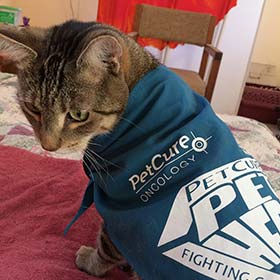Thyroid Cancer In Cats
What is Thyroid Cancer (Adenocarcinoma) In Cats?
The thyroid glands are paired structures located along the windpipe (trachea), about halfway down the neck of cats.
The thyroid glands produce hormones that are vital for normal body function. Thyroid growths in your cat can be benign (adenoma) or malignant (carcinoma). Benign growths tend to get larger and may produce excess hormones; malignant growths can also spread to other parts of the body.
How To Make An Appointment
Reach out to us at (833) 738-4376, or streamline your request by selecting one of the options below:
Does My Cat Have a Thyroid Tumor?
Signs & Symptoms of Adenocarcinoma (Thyroid Cancer)
Benign tumors of the thyroid gland are common in cats. Here are the symptoms commonly related to adenocarcinoma of the thyroid:
- A large fixed or movable mass in the neck
- Difficulty breathing
- Difficulty swallowing
- Weight loss
- Hoarseness/change in meow
- Increased thirst
- Increased amount and/or frequency of urination.
It is rare for a tumor to affect the hormonal function of the thyroid. However, it can happen, and in those cases, you will see additional symptoms. With hypothyroidism, your cat could be lethargic, have some hair loss, and suffer from exercise intolerance.
Diagnosis & Staging a Thyroid Tumor in Cats
The common diagnostic techniques used to detect thyroid cancer include thorough physical examination, complete blood count, serum chemistry panel, urinalysis, (three-view) thoracic radiographs, and cytologic or histologic evaluation of the regional lymph nodes. Advanced imaging (ultrasound or CT or MRI) is sometimes advised, to determine the extent of the disease. Ultimately, a tissue biopsy may be necessary in order to make a definitive diagnosis. Undergoing these tests will help to evaluate the stage that the disease has reached.
Treatment Options for Adenocarcinoma (Thyroid Tumor) in Cats
The course of treatment will depend upon the size of the tumor, the extent of pervasiveness, the presence or absence of metastasis, and whether there are signs of thyrotoxicosis (a condition in which the thyroid gland produces excessive hormones). Surgical removal of cancerous thyroid tumors is often difficult because they can invade local blood vessels or other tissues. Therefore, radiation or chemotherapy is most often recommended for those masses that are incompletely removed or are too large for a successful surgery. Stereotactic radiation (SRS/SRT) is an advanced form of radiation therapy that has been proven effective in treating humans with cancer, including thyroid cancer. SRS/SRT is designed to cure cancer, not just ease the symptoms. What sets SRS/SRT apart is its unprecedented precision, which enables the destruction of the tumor with minimal damage to the healthy cells around it. SRS/SRT is a nonsurgical therapy that supports improvement in your pet’s quality of life. There are far fewer treatment sessions, anesthetic events, and side effects, compared to conventional radiation therapy. Radioactive iodine (I-131) treatment has often been shown to be an effective adjunct to the treatment of thyroid tumors in cats. I-131 can be utilized in cats that are poor surgical candidates or where vascular invasion has been identified in spite of surgical removal. A comprehensive examination of the removed tumor is important, to determine if any additional treatments (chemotherapy, radiation therapy, I-131 treatment, etc.) would be beneficial.
Thyroid Tumors in Cats: Life Expectancy, Survival, & Prognosis
Surgical removal of thyroid tumors has the best outcome if the mass is freely movable, less than 4cm in size, has not spread and can, therefore, be completely removed. Long-term survival (1 to 3 years) may be achieved in cats. It is common for medications to be needed after surgery. If both thyroid glands are removed, your veterinarian may also need to check your cat’s calcium levels several times during recovery. This is because some parathyroid tissue is removed with the thyroid glands, and parathyroid glands play a role in calcium regulation. If surgery is not possible, then SRS/SRT may be a viable and successful option.
Meet our Pet Hero – Thyroid Cancer Survivor Liza!
We’d like you to meet our Pet Hero Liza, a 10-year-old Collie who was successfully treated for thyroid cancer at PetCure Oncology in Cincinnati. Early in 2015, Liza began having health issues that prompted a trip to see the family veterinarian. Liza’s parents explained that she was coughing frequently and seemed to be trying to clear her throat. Her bark had also changed, becoming hoarse and dry. Over time, Liza’s breathing became strenuous and the family felt a lump on her neck….
Questions? We are here to help.
No one knows your pet better than you do. If you see any possible signs of thyroid cancer in your cat, do not hesitate to contact your primary care veterinarian for a comprehensive evaluation. As with any illness, early awareness and detection is the key to successful treatment. If your pet has been diagnosed with cancer, contact our Pet Advocates at 833-738-4376. Our team members are ready to help answer your questions.
If your pet is displaying any symptoms of cancer or has been diagnosed with cancer, sort below by cancer type or tumor location to learn more about each cancer type and available treatment options for your pet. Click on the links for more specific information on treatment and real patient stories.
BRAIN TUMORS IN CATS
- Gliomas in Cats
- Meningiomas in Cats
- Pituitary Tumors in Cats
EXTREMITY TUMORS IN CATS
HEAD & NECK TUMORS IN CATS
- Acanthomatous Amelioblastomas in Cats
- Adenocarcinomas in Cats
- Fibrosarcomas in Cats
- Nasal Tumors in Cats
- Oral Cancer in Cats
- Oral Melanomas in Cats
- Oral Squamous Cell Carcinomas in Cats
- Plasmacytomas in Cats
- Thyroid Tumors in Cats
PELVIC CANAL TUMORS IN CATS
- Anal Gland Adenocarcinomas in Cats
OTHER TUMORS IN CATS
CARCINOMA/EPITHELIAL IN CATS
- Adrenal Tumors in Cats
- Anal Gland Tumors in Cats
- Basal Cell Tumors in Cats
- Biliary Cancer in Cats
- Bladder & Urethra (Transitional Cell) Cancer in Cats
- Chemodectomas in Cats
- Ear (Ceruminous Gland) Cancer in Cats
- Liver (Hepatocellular) Cancer in Cats
- Lung (Bronchogenic/Non-Small Cell) Cancer in Cats
- Nasal (Sinonasal/Paranasal) Cancer in Cats
- Neuroendocrine Carcinoma in Cats
- Pancreatic Cancer in Cats
- Perianal Cancer in Cats
- Kidney (Renal) Cancer in Cats
- Salivary Gland Tumors in Cats
- Squamous Cell Carcinomas in Cats
- Thymoma (Epithelioid) Cancer in Cats
- Thyroid Cancer in Cats
- Tonsillar Cancer in Cats
ROUND CELL CANCER IN CATS
- Kidney Tumors in Cats
- Lymphoma in Cats
- Mast Cell Tumors in Cats
- Melanoma in Cats
- Multiple Myeloma in Cats
- Plasmacytoma in Cats
- Thymoma (Lymphoid) in Cats
SARCOMA/MESENCHYMAL CANCER IN CATS
- Brain (Astrocytoma) Cancer in Cats
- Brain (Choroid Plexus) Cancer in Cats
- Bone (Osteosarcoma) Cancer in Cats
- Brain (Glioma) Cancer in Cats
- Brain (Meningioma) Cancer in Cats
- Chondrosarcoma Cancer in Cats
- Ependymoma Cancer in Cats
- Fibrosarcoma in Cats
- Hemangiopericytoma in Cats
- Histiocytic Sarcoma in Cats
- Injection Site Sarcoma in Cats (FISS)
- Peripheral Nerve Sheath (Schwannoma) Tumors in Cats
- Multilobular Osteochondroma in Cats
- Oligodendroglioma in Cats


